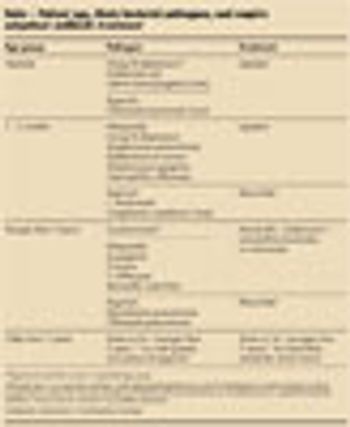
Does an early diagnosis of schizophrenia really make a clinical difference?

Does an early diagnosis of schizophrenia really make a clinical difference?

Three twin studies published between 1977 and 1995, which provided the main body of knowledge on heritability of autism, showed a concordance rate of 72% for a total of 36 monozygotic pairs and a concordance rate of 0% for 30 dizygotic pairs.

In this article the topic addressed are the primary reasons for the American public’s disenchantment with psychiatry; how the profession ought to address these issues; and how we need to replace the DSM’s categorical system with one that is clinically useful for both clinicians and patients.

While SSRIs and SNRIs are valuable in the treatment of major depression, partial response or nonresponse occurs in many patients. Research has found that bupropion was the most frequently chosen agent for addition to an SSRI after inadequate response.

This letter was sent to the APA Trustees and to the DSM-5 Task Force on February 12, 2012, under the title, “Heads Up And Recommendations.”

What is often forgotten, however, is that things such as client-centered therapy, “mental hygiene,” and “self-help” were also responses to another phenomenon-the charismatic physician.

Dogs, indeed, may be man’s (and woman’s) best therapist at certain times and in certain situations, with important implications for mental health.

This article aims to provide a glimpse of recent developments that are relevant to cultural and ethnic influences on psychopharmacological responses.

The articles cover a broad array of controversial and advancing topics in psychiatry. We hope you will enjoy them.

The plain fact is that nothing that has been claimed in the name of defending our country can justify cruel, inhuman, and degrading treatment of another man or woman. Torture, in any form-light or heavy-is not a tool of interrogation or useful for gathering good intelligence.

Effective, early intervention and appropriate support for and treatment of the caregivers of these vulnerable children will improve short-term outcomes and also may provide positive lifelong benefits.

Knowing from the start how a personality is organized, especially as theorized by Karen Horney-appreciating the primary and repressed moves of the patient, inner dictates, claims, idealized image, and intrapsychic defensive maneuvers-makes the help we offer most likely to succeed.

Although the adverse-effect profile of older, conventional (typical) antipsychotics has discouraged many clinicians from using them, they remain widely used in elderly patients with dementia.

Body and soul-brain and mind: two complex worlds mutually dependent and yet in many ways self-governing.

Studies of mammalian species suggest that they possess awareness of self and even more subtle “human” qualities associated with empathy and social joy.

While there are currently no treatments for AD, it is important to examine what we are treating. By the time AD is diagnosed by clinical symptoms, 8 to possibly 15 years of pathological damage has already occurred.

In my experience these are the common complaints by residents who want to come to work tie-free and some simple rebuttals if you, as I do, wish to see future male psychiatrists adorning neckwear

Mrs E, who is 80 years old, lives in the community with the help of a 24-hour-a-day home health aide. She is forgetful and requires assistance with many activities of daily living.

In a recent college course, Dr Eghigian asked his students to discuss long-term patterns and trends in the history of the handling of mental illness. He was struck by a recurring tendency. Most students portrayed the history of mental health in one of two ways.

Until yesterday, there were only 2 reasons to stick with the projected date of DSM-5 publication (May 2013). The first just dropped out.

Much of the controversy on the relationship between grief and depression following recent bereavement has focused on whether the so-called “bereavement exclusion” in DSM-IV should be eliminated, as some have proposed, in the DSM-5.

HIPAA and privacy: To what extent should parents involve themselves in the mental health treatment of an adolescent?

Here we summarize the evaluation of pediatric pneumonia and offer our management recommendations-based on a literature review and on clinical experience-in the outpatient setting.

Each of the boys in question could meet criteria for the DSM-5 proposed criteria for Disruptive Mood Dysregulation Disorder (DMDD). But do you think that these presentations are all the same syndrome that share a similar neurobiological basis, family history, and response to treatment?

Reimbursement? Diagnostic debates? Insurance? Privacy? Ethics? What is the challenge for psychiatrists?

We invite you to weigh in on the case vignettes presented in this space. The cases are culled from the real-life experiences of the authors, and many have previously been published in Psychiatric Times within the context of a clinical article. The identity of the patients in each of these cases has been altered. We feature them here because each case involves at least one diagnostic or therapeutic decision dilemma.


The first half of the 20th century saw 2 world wars, indiscriminate aerial bombing of civilians, the dropping of the atomic bomb, and the Holocaust-all of which created intense trauma for soldiers and civilians.Yet it was not until the American intervention in a post-colonial civil war in Southeast Asia that the psychiatric community in the 1970s formally described what we now call PTSD.

In many climates, a cold February is relieved a bit by the Super Bowl and then by Valentine’s Day-a symbol of hope for falling in love, sometimes suddenly and unexpectedly.

Here we present how to assess safely patients who become oppositional or menacing in a clinic or office.